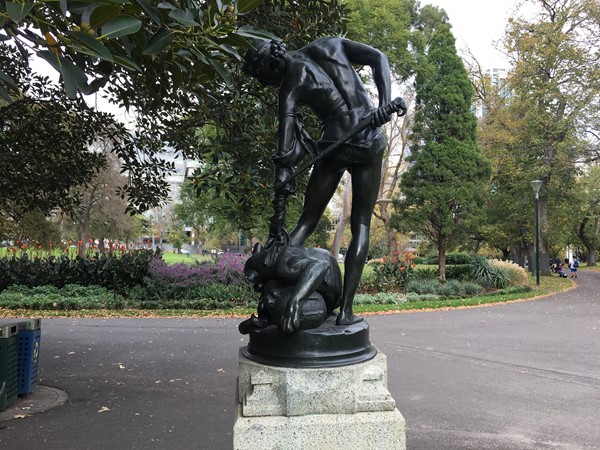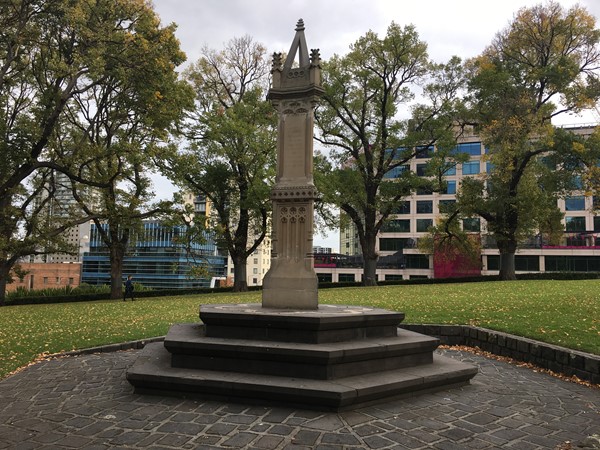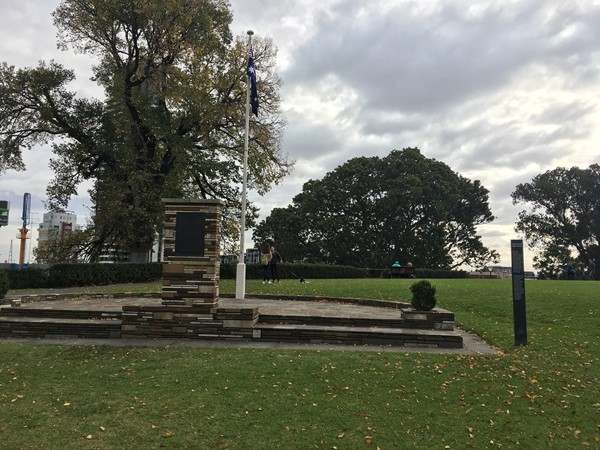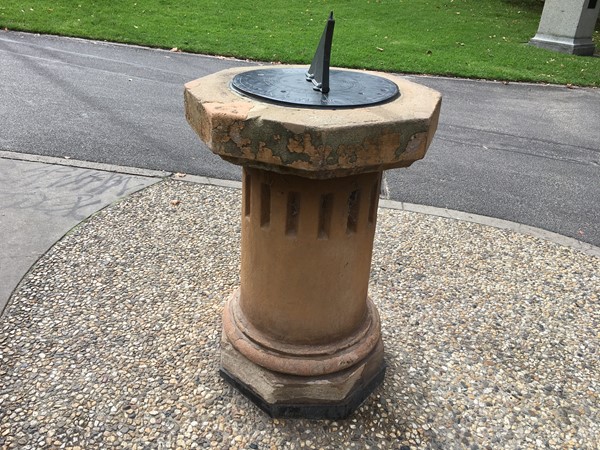Flagstaff Gardens (West Melbourne)

.jpg)
Flagstaff Gardens, which was first established in 1862, is the oldest park in Melbourne. The park is named for the flagstaff erected on this hilly location in 1840, part of a signalling system between the burgeoning town of Melbourne and ships sailing into port. For the first few years of European settlement, the hill accommodated Melbourne's first burial ground until a cemetery was established nearby on the site of the present Queen Victoria Market. A memorial was erected in 1871 marking the approximate position of the settlers' graves.
Flagstaff Hill was a popular meeting place, where the latest 'news from the Bay' could be had and fine views enjoyed. It was also popular as a place to fight duels. In 1850 it was the scene of celebrations when news arrived of the impending Separation of the Port Phillip District from New South Wales. Not long after, the electric telegraph superseded signalling flags and the hill lost its attraction as a rendezvous. The signal station was converted to the Flagstaff Observatory, but the site proved unsuitable and the equipment was relocated to the Melbourne Observatory.
In 1862 West Melbourne residents petitioned the government to turn the by then derelict hillside into public gardens. Clement Hodgkinson, designer of the Fitzroy Gardens and Treasury Gardens, prepared a plan for the 7-hectare site and directed its implementation. Originally decorated with copies of classical statues and densely planted with trees, the gardens are now much changed in character. Extensive lawns and flowerbeds have replaced many trees, and tall buildings obscure views of Port Phillip Bay. A monument was built in 1950 on the site of the old flagstaff to mark Victoria's centenary of self-government. Once serving a densely populated residential district, today the gardens are mainly used by office workers.
The gardens are notable for their archeological, horticultural, historical and social significance to the history of Melbourne.
The gardens are 7.2 hectares (18 acres) in size. The park contains extensive lawns with a variety of mature trees, flowerbeds and wild animals including possums. The southern end is characterised by deciduous trees, while the northern end contains mature eucalypts. Avenues of elms shade pathways along with several large Moreton Bay Fig trees.
The north corner contains a bowling lawn, rose beds, flower and shrub beds. Along William Street there are tennis courts, which also double as volleyball, handball and netball courts. There is a nice playground.
Scattered about the lawns and gardens are memorials and sculptures that illuminate some of the social significance of the area.
Sculptures and Monuments:
The Court Favorite

by Paul Montford
The Court Favorite captures the action of a lithe youth playing with his boisterous pet lion cub. The cub crouches low and tugs fiercely at the youth's cloak. In his right hand the youth clasps a decorated baton, its handpiece a carved elephant head.
Pioneer Monument

by Samuel Craven (1871)
Flagstaff Gardens once had special significance for the people of Melbourne. It was a place of hope and a place of sorrow. Early colonists could sight incoming ships from this high point, which brought tangible links with the old country; and known as Burial Hill, it was also the city's first burial ground. This latter role is reflected well in the Gothic architecture of the memorial, for as if wrested from an English church it is a reminder that this final resting place for an estimated six early settlers is a long way from 'home'.
The rapid growth of Melbourne made the site unsuitable as a cemetery, so a new burial ground was established at what is now Queen Victoria Market. Save for two wattle trees, the graves of the first buried went unmarked until 1871. The Department of Public Works then commissioned a sandstone obelisk by Samuel Craven for this purpose, its pointed uppermost section now missing. The memorial was erected in April 1871, and at the time of its unveiling a large cross was cut into the lawns surrounding it. Its inscription reads: 'Erected in 1871 to the memory of some of the earliest of the pioneers of this colony whose remains were interred near this spot'.
Separation Memorial

Flagstaff Gardens was the site from which news of Victoria's separation from NSW was signalled to Melbourne residents through the lighting of a great bonfire. This mixed stone sculpture was created in 1950 to mark the centenary of the proclamation of separation.
Flagstaff Gardens Sundial

The circular bronze sundial is about 40cm across and was originally constructed primarily from sandstone in the 1800s and sits on a cement-rendered sandstone plinth and bluestone hexagonal base which was reconstructed in 1947.
Access for Dogs:
Dogs are permitted on-lead.
Photos:
Location
Cnr William Street and Abeckett Street, West Melbourne 3003 View Map








